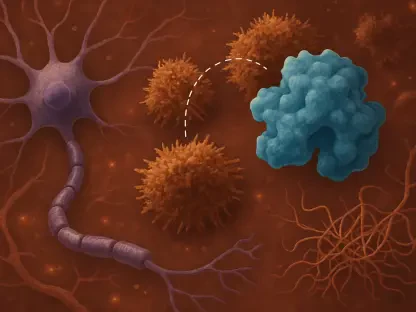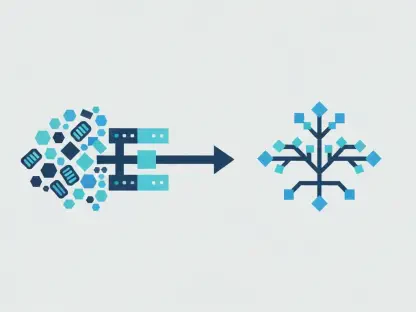In the realm of liver disease research, metabolic-associated steatohepatitis (MASH), a severe form of fatty liver disease also known as metabolic dysfunction-associated steatotic liver disease (MASLD), stands as a formidable challenge with potentially devastating consequences. Characterized by excessive fat accumulation in the liver, inflammation, and fibrosis, MASH can progress to life-threatening conditions like liver failure or cancer, especially in those with metabolic disorders such as obesity or diabetes. With limited treatment options currently available, the medical community is eagerly seeking innovative therapies to address this growing health crisis. A promising candidate has emerged in the form of miricorilant, an experimental oral therapy under investigation by Corcept Therapeutics. This drug is now at the center of a pivotal clinical trial that could reshape the landscape of MASH management, offering hope to millions affected by this condition.
Exploring the Promise of Miricorilant
Early Findings and Therapeutic Potential
The journey of miricorilant began with encouraging outcomes from a Phase 1b study, where the drug showcased its ability to significantly reduce liver fat content while improving overall liver health and metabolic markers. Notably, participants in that initial trial experienced these benefits without encountering serious side effects, marking miricorilant as a well-tolerated option. This early success has fueled optimism about its potential to address the underlying issues of MASH, a disease driven by complex interactions between fat buildup and inflammation. Unlike existing treatments that often fall short in efficacy or safety, miricorilant’s targeted mechanism focuses on modulating cortisol activity, a stress hormone linked to metabolism and inflammation. By honing in on specific cortisol receptors, the therapy aims to mitigate liver fat accumulation and related damage, paving the way for a novel approach that could fill a critical gap in current medical strategies for managing this severe liver condition.
Mechanism Behind the Innovation
Delving deeper into miricorilant’s approach, its selective modulation of cortisol receptor activity stands out as a groundbreaking strategy in tackling MASH. Cortisol plays a significant role in regulating metabolic processes and inflammatory responses, and its dysregulation is believed to contribute to the progression of fatty liver diseases. By targeting specific pathways, miricorilant reduces the harmful effects of cortisol without the broad suppression seen in nonselective treatments, which often lead to unwanted side effects. This precision offers a safer profile while aiming to improve key health indicators like liver fat content and metabolic balance. The drug’s design reflects a nuanced understanding of the biological drivers behind MASH, positioning it as a potential game-changer. As research progresses, this mechanism could not only address symptoms but also alter the disease’s trajectory, providing a more sustainable solution for patients grappling with severe liver complications.
The MONARCH Trial: A Closer Look
Design and Objectives of the Study
The Phase 2b MONARCH clinical trial, conducted by Corcept Therapeutics, represents a critical step in validating miricorilant’s efficacy for MASH treatment. With nearly 200 adult participants enrolled across sites in the U.S. and Puerto Rico, the study is close to full capacity, reflecting strong interest in this potential therapy. Participants, all with biopsy-confirmed MASH, are divided into groups receiving either miricorilant or a placebo over a period of 24 to 48 weeks, with varying dosing schedules to assess optimal impact. The primary goal is to measure reductions in liver fat content using MRI scans, a direct indicator of disease severity. Beyond this, the trial evaluates secondary outcomes such as liver stiffness—a marker of scarring—along with body weight, blood lipid levels, and indicators of liver damage and fibrosis. This comprehensive approach ensures a thorough understanding of the drug’s effects on multiple facets of the condition, setting a high standard for clinical evaluation.
Anticipated Outcomes and Broader Implications
As the MONARCH trial progresses, anticipation builds around its potential to confirm miricorilant’s early promise, with initial results expected late next year. Success in this study could signify a major breakthrough, especially given the secondary focus on whether the therapy can resolve MASH or reduce fibrosis without worsening other aspects of the disease. Such outcomes would address significant unmet needs in a field where current options often fail to halt progression or come with substantial risks. The trial’s holistic goals highlight the importance of not just treating symptoms but improving overall liver health and metabolic function. Beyond individual patient benefits, positive results could influence future research directions, encouraging the development of similarly targeted therapies. The broader impact on healthcare could be profound, potentially reducing the burden of severe liver complications linked to metabolic disorders and reshaping treatment paradigms for millions worldwide.
Looking Ahead: The Future of MASH Management
Reflecting on Trial Milestones
Looking back, the journey of miricorilant through its early Phase 1b study revealed a compelling foundation, as it swiftly reduced liver fat and enhanced metabolic health with minimal adverse effects. The subsequent design of the MONARCH trial built on those insights, incorporating rigorous testing across a diverse participant pool to ensure robust data. Each phase of evaluation meticulously assessed critical markers, from fat content to fibrosis, demonstrating a commitment to scientific precision. The optimism expressed by experts, including Corcept’s chief development officer, Bill Guyer, underscored the hope that surrounded this therapy from its initial stages. These milestones, achieved through careful planning and execution, provided a clear path toward understanding how miricorilant could address the complexities of MASH, a condition long plagued by limited therapeutic success.
Next Steps for Innovation in Liver Disease
Moving forward, the focus must shift to analyzing the MONARCH trial’s forthcoming data to determine miricorilant’s true potential in transforming MASH treatment. Stakeholders in the medical field should prepare for the integration of such innovative therapies into clinical practice, ensuring that healthcare systems are equipped to adopt new protocols if results prove favorable. Additionally, continued research into cortisol modulation could inspire parallel advancements, targeting other metabolic liver conditions with similar precision. Collaboration between researchers, clinicians, and policymakers will be essential to streamline approval processes and make effective treatments accessible to those in need. The path ahead also calls for sustained investment in studies that explore long-term outcomes, ensuring that therapies like miricorilant not only address immediate symptoms but also prevent progression to severe complications. This proactive approach could redefine standards of care, offering a brighter future for patients battling this challenging disease.









